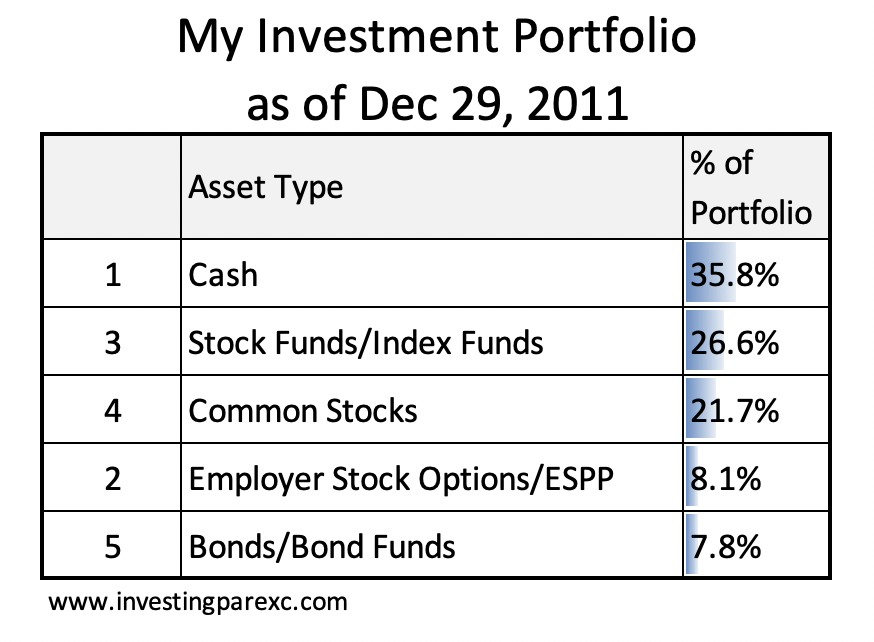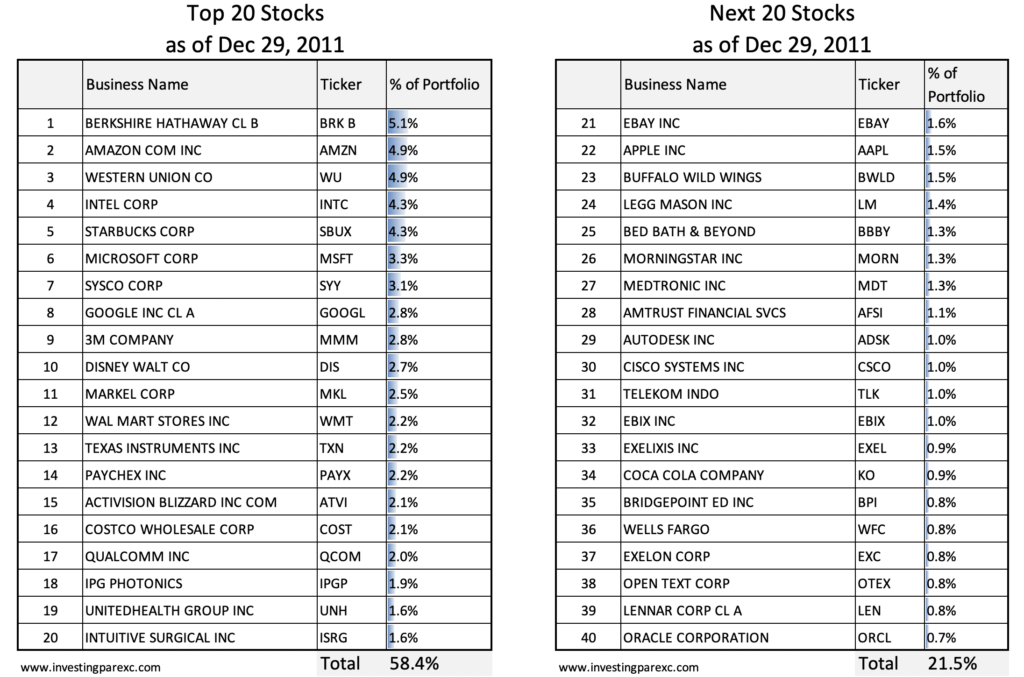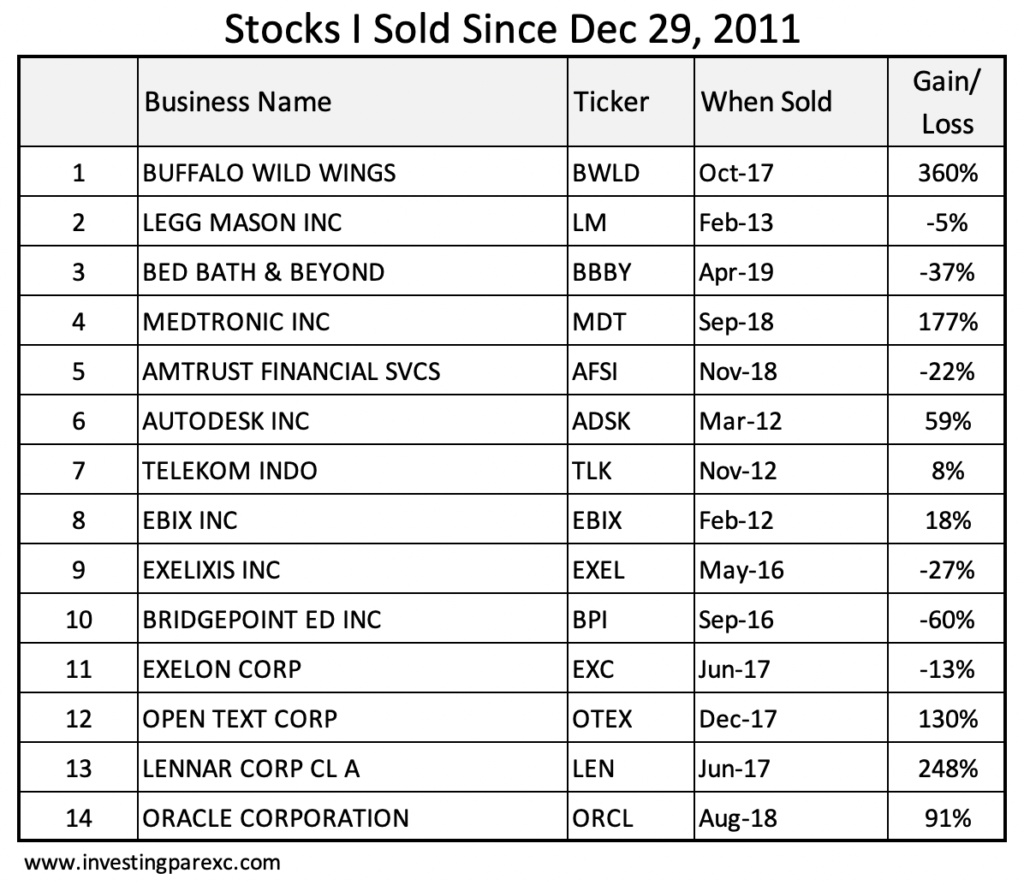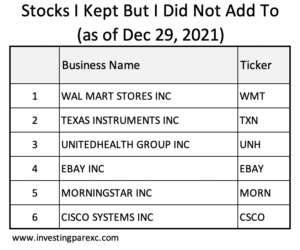
This post is a trip down the memory lane. Ten years ago (December 29, 2011, to be specific), I had a smaller investment portfolio that also looked much different. It sported more cash. It had more stock mutual funds than individual stocks. I still had some employer-granted stock options and RSUs in it.
Let’s take a deeper look. What I had in my investment portfolio then, and how I was thinking about it at the time.
I keep an investment journal and add regular entries in it when I make a major investing decision. Or when I am researching a new business or just following up on an existing one.
I also track my portfolio via software (I’ve been using Quicken Premier since 2007). All my investing transactions are recorded. The tool allows me to go back in time and see where my investments were at any given date.
So, with my journal entries and a handy portfolio analyzer tool, I am able to reconstruct a snapshot to December 29, 2011. Here’s how my portfolio looked that day:

Why so much cash? I had about one-third in cash, but this was not a knee-jerk reaction to the 2008 bear market. Since the onset of the great market sell off in 2008, I had been sitting on unexercised stock options (and some ESPP stocks). I hadn’t sold any since 2007. As stocks prices began their recovery in 2Q 2009, these options had also moved from deep under-water to moderately profitable. So, beginning in June 2010, I started disposing them off. As a result, by the end of 2011, I had accumulated quite a bit of cash, as evident from the table above.
But this cash was not meant to stay. As I found opportunities in stocks, I was going to invest this cash. At the time, I hadn’t yet developed my dry powder strategy. But I was already a believer in dollar-cost investing. [For instance, see my 20-year 401K investing journey in this post.] Over the following three years, I was able to deploy most of the cash I had raised from employer options/RSUs into individual stock positions.
Stocks versus stock funds? In 2011, I had more invested in index funds than in individual securities. I had been investing in stocks since 1992 [see here and here.] But I didn’t begin to take individual stock investing seriously until 2007 [see a recount of it in this post.] Other than occasional dabbling in them during the 1998-2000 tech boom era. By the end of 2011, I had built a sizable position in individual stocks. In the following five years, I continued to whittle down my index funds and replace them with individual stocks.
What stocks did I own in 2011? Back then, I had casted a wide net in search of good businesses. My top 20 positions made up only about 60% of the total invested funds. The next 20 positions brought up another 20%. In contrast, today my portfolio is much more concentrated. [My top 20 positions in Feb 2020 made up about 78% of the total, as I reported in this blog post.]

It was my relative inexperience with individual stocks that had resulted in my owning too many stocks. At the time, I was subscribed to several investment newsletter subscriptions, from services like Motley Fool, Morningstar Premium, and The Prudent Speculator. I was buying stocks based on their monthly recommendation, with some, albeit limited, due diligence of my own. I was learning as I invested. Many of my good purchases (call them beginner’s luck) at the time came courtesy of a stock recommendation service. A lot of my bad buys also came the same way.
In the later years, I gradually cut down (or cleared out entirely) what I considered my investing mistakes. From what I had owned at the end of 2011, these were stocks that I ended up selling over the following years. See below table. Some I sold for a loss while others made good money for me. But over time I had realized that these were not the kind of businesses I’d like to own for the long haul.

From that era, there were also half a dozen names that I did not close out nor invested further in them. I just kept the shares I had. These were all excellent businesses, though some were better than others.

Two names to highlight from that list are eBay (EBAY) and UnitedHealth Group (UNH). eBay did fine for me over the last decade but more importantly it spun off PayPal in 2015. Since then, PayPal had been a remarkable success story for my portfolio. My PayPal shares today are worth about 7x my original cost basis in eBay.
UnitedHealth is another excellent holding for me. Regrettably, I only bought shares twice, once in 2007 and then in 2008. Since then, I have been collecting its rapidly rising dividends (five-year dividend increase at 18% CAGR). So far, my multiple on invested capital is 13.75x.
The rest of the stocks from 2011 were those that I had kept on adding to over the years. Many of these I’d highlighted in previous blog posts as excellent quality businesses. Among them, those that did the best make up my top-10 holdings today (see this table), with the exception of Tesla and Blackstone (I didn’t start buying them until later in the decade). Moreover, sixteen of my top-20 stocks today (as of Dec 2020, see this) are also from this 2011 list (Applied Materials and Mastercard were bought later).
Among those that I have kept adding to, there are two laggards: Wells Fargo (WFC) and Western Union (WU). I am just about break even on Wells Fargo. Its recovery from the Great Financial Crisis has been slow. And then it got embroiled in the fake accounts scandal. Today WFC has new management, and I am expecting better business performance once it is allowed to resume growth of its deposit base.
WU had a durable and moaty business model but not much growth. I was expecting it to transition more quickly to online remittance market to fend off new competition. It hasn’t been able to do that. Today I’m in the process of liquidating my entire position in it.
I am patient with my purchases (may be a bit lazy too). I don’t usually sell what I buy unless it was a mistake to buy in the first place. If I need to raise some cash, I sell a fraction of a stock position (see this: Buy right, sell never). It keeps me from overpaying capital gains tax. Besides, good businesses that are run by trustworthy managers are for keeps.
In my next blog post, I will recap my performance in 2021 and share how my top-20 stocks looked at the end of the year.
Hi MC
thanks for posting about your investment journey over the last ten years
in your post in Nov 2017, you make the following comment
“I buy individual stocks mainly because I have a deep interest in learning about business models and finance. The jury is still out on whether I can beat a broad market index with my stock picking skills. I make no claim of superior insight – still I enjoy spending time researching businesses and making educated bets on their future.”
I wondered whether you have formed a view as to whether you can actually beat the market indices, or whether that is not that important to you because you like to put in the mental effort to select your shares
I suspect that you hold individual shares because you enjoy researching and putting your money on the line – and also it gives you more flexibility – and possibly more conviction to hold during a downturn, as you know the businesses
the other major potential advantage is that you can weight your investments according to your own convictions as opposed to market cap or some other algorithmic tilt
However I have not seen you rebalance your portfolio, although you add to positions from time to time
I have also spent some time considering whether to follow your path and invest in durable long term businesses and generally stop when I consider that I am only likely to end up with a performance below the QQQs, which would likely lead to adverse emotional reactions!
Lastly do you have a view on the outlook for 2022. I suspect it will not change your investments or investment approach, but I am struggling to see how the S & P/QQQ earnings multiple can stay at these levels indefinitely – and with little or no earnings growth forecast for 2022 and rising interest rates and inflation, could very well start to contract
Thank you for asking some very insightful questions.
“I wondered whether you have formed a view as to whether you can actually beat the market indices” —— I showed my one-year (2020) return in this post (https://www.investingparexc.com/2021/02/16/stocks-did-in-2020/). That year, I did beat both NASDAQ and S&P500. I plan to write another post soon that would cover 2021 and previous 3-5 year performances.
“I suspect that you hold individual shares because you enjoy researching and putting your money on the line – and also it gives you more flexibility – and possibly more conviction to hold during a downturn, as you know the businesses” —— This is great insight. Indeed it is true that I like researching businesses and I have higher conviction in holding them through thick and thin. Well said!
“I have not seen you rebalance your portfolio, although you add to positions from time to time” —— True, I don’t reduce my winning positions. I like to remind myself of Peter Lynch’s admonition of not cutting your flowers and watering your weeds. I do sell fractions of my positions when I need to raise cash. Lately I’ve done that to raise the level of dry powder cash I am holding.
“Lastly do you have a view on the outlook for 2022” —— I don’t. I am agnostic to the market’s year-over-year changes. If it goes down significantly, I stand ready to deploy my dry powder cash. Ken Fisher, whose views I respect, like to say that valuations are not good predictors for the markets. In terms of prevalent sentiment, I think this bull market is somewhere between optimism and exuberance phases. But this could last for a long while.
Happy investing!
Hi MC
Clearly moving away from optimism and exuberance atm
Dry powder at the ready!
Or will you wait until you see some sort of bottom forming on the correction on what has been a very overvalued market?
Hi Nicholas, I don’t know how to detect a bottom, so I invest using a rule book. Since S&P 500 went below 10% this morning, I started deploying first tranche of dry powder. Will write about it at a later date.
See this:
https://www.investingparexc.com/2018/07/30/mechanical-investing-approach/
http://www.investingparexc.com/wp-content/uploads/2018/01/Screen-Shot-2018-01-07-at-11.47.36-AM.png